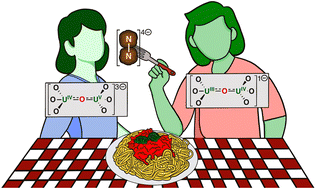Dinitrogen cleavage by a dinuclear uranium(iii) complex†
Abstract
Understanding the role of multimetallic cooperativity and of alkali ion-binding in the second coordination sphere is important for the design of complexes that can promote dinitrogen (N2) cleavage and functionalization. Herein, we compare the reaction products and mechanism of N2 reduction of the previously reported K2-bound dinuclear uranium(III) complex, [K2{[UIII(OSi(OtBu)3)3]2(μ-O)}], B, with those of the analogous dinuclear uranium(III) complexes, [K(2.2.2-cryptand)][K{UIII(OSi(OtBu)3)3}2(μ-O)], 1, and [K(2.2.2-cryptand)]2[{UIII(OSi(OtBu)3)3}2(μ-O)], 2, where one or two K+ ions have been removed from the second coordination sphere by addition of 2.2.2-cryptand. In this study, we found that the complete removal of the K+ ions from the inner coordination sphere leads to an enhanced reducing ability, as confirmed by cyclic voltammetry studies, of the resulting complex 2, and yields two new species upon N2 addition, namely the U(III)/U(IV) complex, [K(2.2.2-cryptand)][{UIII(OSi(OtBu)3)3}(μ-O){UIV(OSi(OtBu)3)3}], 3, and the N2 cleavage product, the bis-nitride, terminal-oxo complex, [K(2.2.2-cryptand)]2[{UV(OSi(OtBu)3)3}(μ-N)2{UVI(OSi(OtBu)3)2(κ-O)}], 4. We propose that the formation of these two products involves a tetranuclear uranium–N2 intermediate that can only form in the absence of coordinated alkali ions, resulting in a six-electron transfer and cleavage of N2, demonstrating the possibility of a three-electron transfer from U(III) to N2. These results give an insight into the relationship between alkali ion binding modes, multimetallic cooperativity and reactivity, and demonstrate how these parameters can be tuned to cleave and functionalize N2.



 Please wait while we load your content...
Please wait while we load your content...